Garrett Family
Dear Wayne and Stephanie,
Let me explain who I am, first of all. My grandfather, David L. Garrett, was the brother to Elsie Jenelia Garrett. When my father, David L. Garrett married my mother, Barbara Louise Bjelke in the 1940's, they were both finished with college and he was with the Signal Corp and stationed in Philadelphia. Great Aunt Elsie asked my parents to come stay at the house with Phyllis and Elaine ( I think were both still college age) while she spent some time in Florida. Later, my parents moved to Colorado, where I was born and they named me after Phyllis Manning.
Bob and Phyllis visited us in Colorado in the early 1980's and then a few years later we had a family gathering at Phyllis and Bob's house and your parents were there also. They were wonderful hosts and it was so nice to meet these extended family members.
I lost touch with the Craigs and my father passed away in 1999 and my mother in 2003. I was thinking about them about a year or so ago and called the Craigs home. Bob answered the phone and said told me that Phyllis had passed away and we had a brief conversation. I later regretted that I had not sent him a note of sympathy and thanked him for being such a good host when we visited. I tried to Google his name to find out if he was still living and came upon your website. I was very surprised to see pictures of my great Aunt Elsie, of Phyllis and Elaine and of my mother! She is the young lady in the headscarf in several of the pictures. In one picture another girl is cupping her chin in her hands and mom is holding a cigarette. She is in another couple of pictures with the same lady and a collie type dog. In another, she and the same lady are kneeling with their heads away from the camera, but they are looking back at the camera. The pictures did not have captions on them so I thought you might be interested in who was in the picture.
Is your mother, Elaine still living? If so, please tell her hello for me. I remember her and Phyllis as being very pleasant people. Is your Uncle Bob still living?
I have a little bit of family history on the Garrett clan if you are interested. I have the names of all the brothers and sisters and where they came from ( Georgia, then Alabama and finally Texas). Although I don't have too much that goes beyond that as far as specifics, I do have sort of an outline of the places they came from in Europe. I can tell you more if you are interested.
Sincerely,
Phyllis L. Garrett
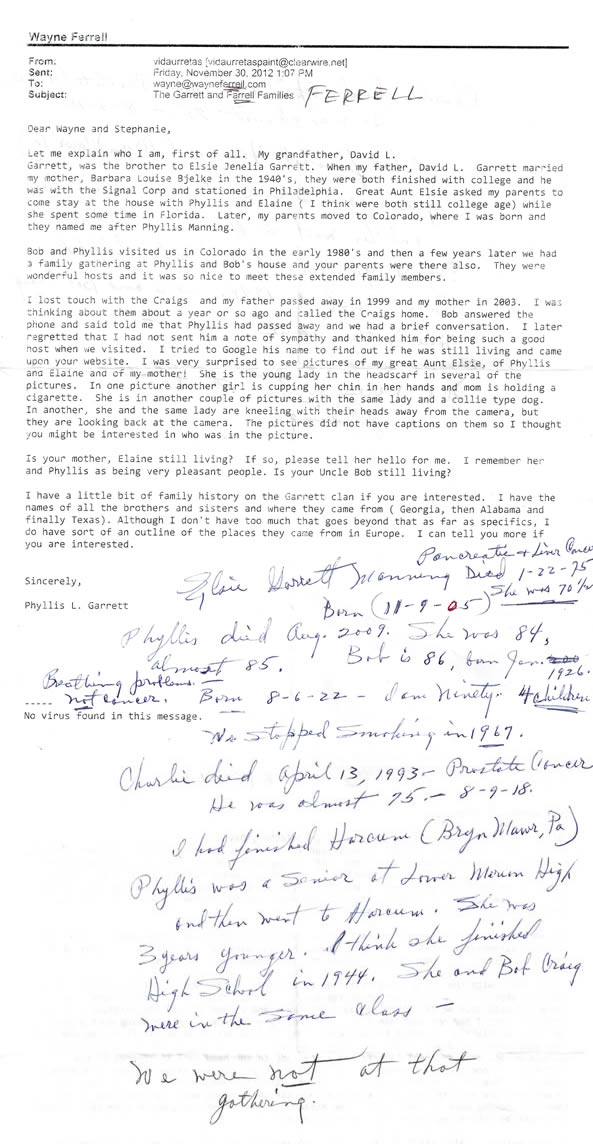
Garrett Name history to 1066
Posted by Donald G. Dickason (172.173.205.122) on January 29, 2005 at 11:20:02:An Annotated Historical Timeline of the Development of the Name
Garrett/Garret/Garratt/Gear—id and also some Fitzgeralds & Chamberlain
Donald G. Dickason, January 2005, Dickason3l@aaol.com
Section I - Summary - The history of the name Garret and variants
Section II - Celtic through Norman to British Isle time line for Garret and variants
Section III - Irish time line for Garret and variants
Section - I , Summary - The history of the name Garret and variants
Etymologists have, for a long time, declared that the name OGarretO comes from the French Gerard (or Girard). But it has not been clear how this evolved. Now there is an interesting historical trail which seems to explain how this happened
About 1086 there were about 18 men whose first names were Gerard within the forces of the Normans under William the Conqueror who invaded the British Isles. Over time il is believed that these Gerard names evolved to Garret (and variants), as well as some Fitzgeralds, and a few Chamberlains. That is roughly the same period during which surnames also began to evolve. The Gerards, loyal to the invading king, became OYeomen,6 administering and sometimes owning land on behalf of the King, and employing the indigenous population. Sometimes these persons were called 6ienants-in-chief,6 or Ounder tenants.
These 18 lines can be sorted out by the use of DNA. Contact the writer for more information.
Some of the descendants of these Gerards eventually came to Ireland and evolved to Garret (and variants) and Gear-—id. Some of these Irish immigrants came to the predominantly Protestant North, the ancestral home of the Dickason Garrets. Others, some now with the Irish spelling of Gear—id, settled in the Catholic South. These and other name trails are spelled out the time lines in Section 11 and Section III below.
The study of Garrett heritage in America has been very active. There are many Garrett citations leading back to England. Prominent lines of these OEnglish GarrettsO emigrated to America in the early 18th century. However the only Garrett lines that have been identified as coming from Ireland or are in Ireland today relate to the DickasonsO ancestral Garrett line. Through the use of DNA various sub lines of Olrish GarrettsO have been proven, probabilistically, lo be closely interrelated. Significant lines of these Olrish GarrettsO emigrated to America in the late 18th and early 19th century.
From the point of view of studying the relationship of various Garret lines it is important to realize that there could be as many as 18 different Garret, Fitzgerald, and Chamberlain lines, each developing from the 18th century yeomen named Gerard. Fitzgerald derives from Oson of Gerald,O an old Irish naming convention. And at least one Gerard became the Chamberlain to King William, and adopted Chamberlain as his name.
I am deeply grateful for the information about the early history of the Garratt/Garret/Gerard names provided to me by Mr. Henry Garralt of England. His perceptive study of this history far exceeds the simplistic comments concerning the history of these names usually offered to interested family historians. 1 have amplified his information with a timeline of events in order to provide perspective. In Section III , 1 have added elements relating specifically to the "Irish Garretts."
The ODomesday Book,0 a survey of British life ca 1066 - 1086 is the major source of the information leading from Gerard to Garrett and variants. The identification of the original 18, plus or minus, Gerards comes from this source. It is impossible to know how many Gerard lines survived independently because some presumably intermarried, and some probably were wiped out by the great plague. Mr. Henry Garratt concludes that Gerards became Garrets or variants on the fact that the geographical locations of the Gerards at the time of the Domesday Survey, were the same geographical locations that Garrets and variants were found in the next 100 years or so. The primary reason for this name evolution was simply the Anglicization of the French Girard to the English Garret or variant.
I have not been able to find the explicit data from that survey, 900 years old, on line . I f any reader of this commentary knows of an on line source of these data, please let me know. In the meantime there is a good description of (but not data from) the The Domesday Book, in Michael WoodOs ODomesday, Search for the Roots of England,0 published in 1986
Donald Garrett Dickason (Dickason31@aol.com)
January 2005
Section II - Celtic through Norman to British Isle annotated time line for Garret and variants
600 1st wave of Celtic invaders
250 2nd wave of Celtic invaders
367 Roman British attacked by Picts and Saxons
367 - 1066 From time to time Nordic raiders arrived on the east coast of the British Isles, starting with Hengist and Horsa, followed later by the Saxons, Jutes, Angles, etc. By the 9th century the Danes were arriving and ruled a section of England now called Lincolnshire and the East Midlands. About the same time the Vikings arrived in the Orkneys and Shellands where their influence persists to this day. Another group of raiders came to the northeast coast of England and settled in York. Recent archaeological excavations have amplified the knowledge of this latter group.
1066 The Normans who conquered England in the year 1066 came from the area called Normandy, but "Norman" is a version of the word "Norseman." A few centuries before the Norman Conquest of England, these people (as then Vikings) had raided the north coast of Europe. This included the whole of the coast line from Latvia through the Baltic, across the Hansealic States through France and Spain as far as Portugal. Although they settled primarily in Western Europe, they did partly colonize the Orkneys and Shetlands, but they never settled in the rest of the British Isles. Normans they were, now quite far removed from their Vikings beginnings. By 1066. though, they had adopted European customs, the French language and Roman Catholic Christianity. These Normans who conquered England were, for their time, very modern Western Europeans. But remember that the invader Prince William was a Norman. But many of his troops were not; Ihey came from a geographical area much broader than just Normandy. The point is that although there were already some Norsemen in the British Isles before 1066, there is no record of anyone named Gerard before the 1066 invasion. These Gerards might have been Norsemen by heritage, or might have been from other parts of Western Europe.
1066 The last stage of a family quarrel occurred at the Battle of Hastings, often referred to as the Norman conquest of England. King William of Normandy attacked the forces of his cousin King Harold of the British Isles, and King Harold was killed. (Cooperation have been belter way!) The important point here is that GERARD was the name of that small group of 18 of King William's invaders.
1086 The 18 men (from the invaders) with the name GERARD that came over with King William, were now the land owners or principal tenants, called Yeomen. Conquering armies typically took the lands, and the Lords gave the tenancies to their soldiers. In this case some were GERARDS. The name GERARD was used only by the conquerors; Saxons would not have used the hated name. Soldiers who became Yeomen retained this position for centuries. They were the middlemen, loyal to the Lords, and they employed the indigenous population.
1086 The Domesday Book occurred at this time. It was a domestic survey including background information in England. In it there were 18 Gerard names which in most cases seem to have a link with the appearance of a GARRET family in the same area toward the end of the middle ages, Ca 1450
1100s The Isle of Man and the great Norman Castle at Peel was taken over by the Norman/English. A few GARRET families may have ancestors that date back to that time, but most will be descended from immigrants related to the Norman/English invasion
1169 Strongbow's Anglo-Normans arrive in Ireland at invitation of the exiled King of Leinster, Dermot McMurrough
By 1200 By this lime most of 1086 GERARD families had adopted the name GARRET but one or two did not. The most famous of these was GERARD of the Chamberlain to King William, who held vast areas of the land between Hereford and Winchester. The First Chamberlain of this family is buried in the Hereford Cathedral, and proudly look the surname Chamberlain. The most notorious of that line was Prime Minister Neville Chamberlain.
Section III - Irish annotated time line for Garrets and variant
Ca 1200 The Irish History of Garrets and Gear—id begins about 1200
Ca 1200? The Normans who had become English conquered Ireland because of its rich agricultural land.
The invading English/Norman troops were lead by a man named GERARD, a powerful Lord. After conquering Ireland, he was given vast estates by the ruling British Monarch.
1200s Ultimately there will be two groups of GARRET families in Ireland. The first group was in the South, mainly around Cobh (today Cork) probably descended from the original Norman soldiers and will also have kept to the mediaeval Roman Catholic faith. The second group of Garrets will come to the North in the 1600s from the lowlands of Scotland. These Garrets will be Protestants. Both groups of families will have descended from the few soldiers name Garret who landed at Hastings in 1066 and who became the Norman Yeomen. But they will have reached Ireland to buy two different routes.
mid 1200s GERARD had changed to GARRET or variants.
mid 1200s Lord GERARD had changed to GERALD through the influence of the local Celtic dialect. In keeping with the Irish naming convention, his son became FITZGERALD, son of Gerald. Thus some of the FITZGERALDS have a common name ancestry with Garret, both from Gerard. Some of the Garret families in Ireland were descended from the soldiers of the Earl Fitzgerald who was Earl Marshal of Ireland.
1200s The spelling of Garret as Gear—id probably first appeared in the 13th century. Very possibly the Roman Catholic priest interpreted the name Gerard into the Irish language, that is, Gear—id.
By 1250 Landlords, and Yeomen as well had adopted surnames. Most of GERARDs had been Anglicized to a modern Garret. This happened throughout the British Isles. The impact of the Saxon and Danish dialects on the Norman names may have something to do with the Anglicizing of Gerard to Garret.
1315 Scots invade Ireland, Edward Bruce named king.
1318 Bruce killed in battle.
1366 Statutes of Kilkenny forbid marriage between Anglo-Normans and Irish.
Ca 1350 The Scots, or Picts, were not defeated by the English until the mid 14th century. Since the 1086 Norman invasion was the beginning of the name source of Gerard (later Garret) there are few or no GARRETs indigenous to Scotland.
Ca 1350 Wales was not subdued by the English (earlier Normans) until the mid 14th century. Since the Normans were the source of Gerard (later Garret) there are few or no GARRETs indigenous to Wales
1347-1351 The "Black Death" plague created turmoil in the feudal system and virtually all social arrangements. The importance of this is that the family descendancies of the 18 or so 1086 Gerards, later Garrets and/or Fitzgeralds, were also thrown into turmoil. There is no way to know how or if some of those descendancy lines were obliterated.
1450 Remember that the 1086 Domesday Book, the domestic survey included 18 Gerard names. We are now at the time when the 1086 Gerards seem to have a evolved to the appearance of a GARRETS in the same geographic areas.
Late 1400s
The first printing press was introduced by Caxton in the British Isles. Variations in the spelling of names, as well as other things, became far less frequent. Garret became the most often used spelling for Gerard, el al.
1541 Henry VIII declared King of Ireland by Irish Parliament.
1557 First plantations established in Offaly and Laois by Mary I .
Prior to 1600
Typically only able to trace heritage of eldest son (due to the long tradition of primogeniture) unless another son married a woman of significant social status from another family.
1607 Old Irish Earls flee lo the continent
1607 Plantation of Ulster.
1649 Cromwell lands in Dublin, razes Drogheda and Wexford; Catholic landowners transplanted to far west, "beyond the pale."
1688 James I I , deposed Catholic king of England, flees to Ireland and raises army.
1689 Siege ofDerry.
1690 William of Orange defeats James I I at Battle of the Boyne: James IPs army surrenders the following year in Limerick.
1695 Penal Code severely reduces rights of Irish Roman Catholics
Prior to 1700
There was a second influx of GARRETs into Ireland (and the Isle of Man) which is in many ways far more important to note than just the interest in Garret history. After the Reformation there was considerable religious strife in Europe and this included the British Isles. In order to escape religious or social persecution quite a number of Scots families moved from the low lands of Scotland to Ireland in this the 17th century. They were mostly Protestants and mainly settled in what we now term Ulster. This settlement process culminated in the battle of the Boyne. There were a number of Garret families who arrived in Ulster at this time. These Lowland Scots were themselves the descendants of the Gerards of the Norman Invaders
Prior to 1700 SUMMARIZING
There is the 2nd of two groups of Garrets in Ireland. The Garrets in the North will be Protestants, having come with this 2nd influx of Garrets from the lowlands of Scotland in the 1600s . The first group, the Garrets in the South, mainly around Cobh, today Cork, were probably be descended from the original Norman soldiers and will also have kept to the mediaeval Roman Catholic faith. Both groups of families will have descended from the few soldiers who landed at Hastings (in today's England) in 1066 and who became the Norman and later English Yeomen. But they will have reached Ireland lo buy two different routes.
1731 First issue of The Belfast Newsletter, the world's oldest continually running newspaper
1759 Arthur Guinness buys the St. James' Gate Brewery in Dublin. (Important personal note!)
1760s Ulster Land war in Counties Donegal, Antrim and some in County Down. Land sold to the middlemen who upped the rent by very large amounts. Tenants became impoverished.
1770s American Revolutionary War. From 1776 to early 1784 trade between America and Ireland collapsed. A specific example was the linen trade and the flax agriculture activities, centered around Lisburn on the border of Counties Down and Antrim. We have hypothesized that the DickasonOs ancestral GGGG Grandfather Garrett was employed in flax growing a scant 5 miles south of Lisburn, County Down. As such he would have been deeply affected by the collapse of the Linen industry and trade
1784 End of American Revolution early Irish came back to visit and American ministers came to Ireland to proselytize. Also merchants from America arrived in Belfast and recruited tradesmen and craftsmen, and their tools, to come to America
1784 The Penal Laws (existing since 1689) were revoked. These Penal Laws had seriously restricted the rights of Presbyterians, "Dissenters," and Catholics. These Penal Laws had earlier been eased in 1778 and 1782, especially for Catholics. Presbyterians became very fearful of the newly empowered Catholics . (The later Catholic emancipation of 1829 triggered a panic in the Protestant community.)
1784 Ancestor GGGG Grandfather Andrew Garrett emigrates to America.
1790 Related ancestor John Garrett, perhaps a GGGGG Uncle, emigrates to America
1800 Act of Union, Ireland legally becomes part of Britain.
1845-50 The Irish Famine. 1000s of Irish emigrated to the United States including many Garretls. These Garretts were themselves descendants from the Yeoman origins previously cited in this timeline.
BOOK I
MISCELLANEOUS RECORDS
PART I
THE GARRETT-GARROTT-GIRARD FAMILY
CHAPTER 1
GARRETT FAMILY ORIGIN
In searching the records it has been interesting to note the different spellings of the surname, Garrett. The following names seem to be interchangeable: Garrat, Garrott, Garat, Garratt, Jarratt, Jarrett, Garth, Garrett, Gerard, Gerrard, Gerald, & Fitzgerald. The latter family located in Accomac Co., Va. early i n the 16th Century, Gov, Henry Wise of Va. Related that in his early law practice he was retained to connect thu Accomac Garretts & Fitzgeralds so that they could claim a large fortune left by a Fitzgerald in England. He said he had but little difficulty in securing legal proof of this & received a substantial fee for his successful search. He found that the name had been altered by American immigrants dropping Fitz & calling themselves Gerald or Garrett which have always been interchangeable. He believed that all families of similar names in Va. & Md, descended from the same Norman ancestors.
MISCELLANEOUS RECORDS
PART I
THE GARRETT-GARROTT-GIRARD FAMILY
CHAPTER 1
GARRETT FAMILY ORIGIN
GARRETT PAPERS OH FIIE AT 1HE
NEW YORK GENEALOGICAL SOCIETY- VOL I
NEW YORK GENEALOGICAL SOCIETY- VOL I
The Garretts were first Gerrards or Gerards from Normany who came with William the Conqueror, They were cloth merchants, or rather, weavers of cloth. They were not Dutch although some are known to have married Hollanders. A branch went to Wales because they could get cheaper fuel & labor for their cloth manufactures & they were called Garrit, Garet, Garat, & sometimes Gerald, They have ever been known as conservative people & good citizens. They espoused, or many did, the Quaker belief in England. Again when the lands of the Irish landlords were sequestered by the English Crown after Cromwell's subjugation of Ireland, quite a number of them went to Ireland, settled on those lands, married Irishgirls and became, to all intents & purpose Irish, An interesting change of the name took place in - the Irish branch of the family — the name Gerald, One of the Geralds added the Fitz (an old Norman French word meaning son). It is also used aaij the surname of illegitimate children of Kings or Princes, The family of Fitzgeralds ruled Ireland until the Geraldine War or the time of tho.raba£w - "lion led by Lord Thomas Fitzgerald, After a long struggle he was captured' with his five uncles who had taken up arms against the King, and all were hanged in the Tower of London.
Sir William Garrard was Lord Mayor of London i n 1551; his son, John Garrett, (mark the change i n name) was raised from Knighthood to Baronetcy of Lamar by James 1 of England. His French ancestor moved from France after the Revocation of the Edict of Nantes by Louis XIV & settled in England, In the course of time family dissensions sprang up & different members, or perhaps branches, assumed different names - such as Garrard, Guerrant, Garratt, & finally Garrett.
The Garrett seat was at Newbury in the County of Berks, near the Windsor Forrest, & their seat of Dorney was in Buckinghamshire, about 60 miles northwest of London. Newbury is still owned by their descendants. They intermarried with the Benets and the Drakes of England – noted on the high seas.
The Gerards, Geralds, Fitzgeralds, Garretts, & Garats were descended from Dominus Otho of the family of Gherardini of Florence, Italy. His descendants took the Latin name, Geraldini. One of this name went to Normandy & from there to England where he became the favorite of William the Conqueror. His large estate passed at his death to his "son Walter Fitz Otho (Castellan of Windsor & Warden of the Forests in the County of Berks). Walter married Gladys, daughter of Rhivallon of Cynfyn, Princess of North Wales. They had three sons:
1. Gerald Fitz Walter, his heir.
2. Robert of Windsor, the ancestor of Baron of Eston, Essex Co.
3 . William de Windsor, the ancestor of Baron Windsor
Gerald Fitz Walter married Festa, daughter of Phys of Gruffyd, Prince of South Wales, They had three sons:
1 . Maurice, his heir.
2. William, ancestor of the families of Carew, Fitzmaurice & Gerard,
3 . David, Bishop of St. David, Died 1176.
From Maurice Fitzgerald sprang the 'Irish Geralds -t the Hake of Leiclster. From William Fitzgerald are descended the relish Gerards, He married Katherine, daughter of Adam de Kinsley of Chester Co. Their son was William, Justice in Eyre, who was the ancestor of William Gerard, who married the daughter & heir of Peter de Bryn of "Bryn", Lancaster County. His son was Peter Gerard died 1381» Knight of Bryn at the time of Edward III . Peter's third son was John Gerard who married Helen, daughter of the heir of Richard de Ince of Lancaster Co, He was the ancestor of the Gerards of Ince & Gerrard, Earl of Macclesfield, (now extinct). Sir Thomas Gerard, the sixth, succeeded to the title of Knight of Bryn & married Frances, daughter of Sir Richard Molineaux, Bart, of Sefton, Their family: six sons £- one daughter. His second son was Richard Gerrard of Ince born 1612 who became a distinguished soldier. The eldest son of Richard, Sir William Gerrard, expended a large estate in the cause of Charles I, He married Elizabeth, daughter of Sir John Preston.
Thomas Gerrard of Ince married a Kiss Eltonhead, Their son, John, settled in Virginia.

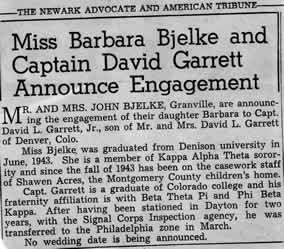
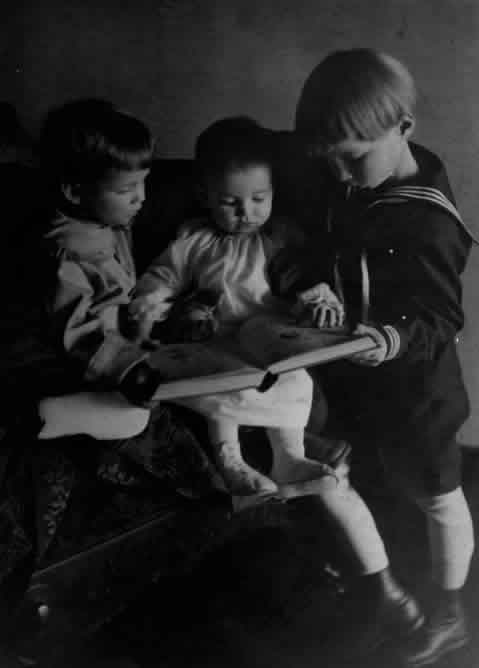
The three oldest Garrett brothers: William Penn, Thaddeus Dulane and David Littleton Jr. in Denver, Colorado in the 1920's Uncle Dick was not born yet.
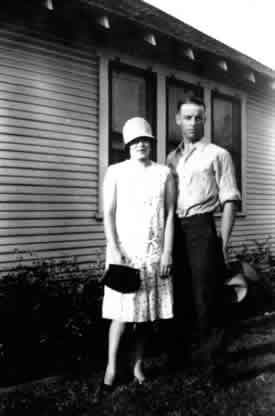
Our great uncle Luther Garrett, with his wife Avon in Austin, Texas.
Luther was the youngest boy and the next child older than Elsie Jenilia Garrett (Who married Phillip Kirkman Manning who were the parents of Margrate Elaine Manning and Phylis Manning. Margrate Elaine Manning married Charles Wayne Ferrell in 1946 and had 4 children who were: Stephanie Elaine Ferrell, Dana Lynn Ferrell, Charles Wayne Ferrell II, and Ann Louise Ferrell). Luther died at a very young age from infection that could have been taken care of by sulpha drugs, that were invented just months later. I visited Avon several times when I lived in Austin in the 1980's and 1990's. She passed away in the 1990's.

Thaddeus Dulane Garrett, the second to the youngest of the four Garrett brothers. He was a skip bombing pilot during WWII and earned a distinguished flying cross. Later he became a pilot for United Airlines.

My son Peter and I visiting with Dorothy Garrett at her home in Big Spring, Texas. She was the daughter-in-law to Will Garrett, our great uncle and the oldest of our grandparents siblings. Will was a prosperous rancher in Big Spring, Texas and then he hit oil on his land and became a billionaire. Dorothy is gone now and only one of her daughters is still living. We were in touch with Dorothy, but do not know her daughter.
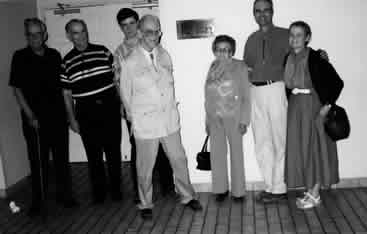
This was a small family reunion around 1996. From left to right:
Uncle Duke ( Thaddeus Dulane Garrett), Uncle Bill ( William Penn Garrett), my son Peter, my father David Garrett, my great aunt Lucyle (my grandmother's sister), my cousin Ricky Garrett (the oldest son of my Uncle Dick, Richard Morgan Garrett) and me. My uncle Dick had already passed away by the time of this reunion and now all the brothers are gone.
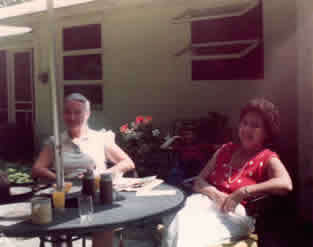
Phyllis and Elaine at Phyllis' house in Malvern, PA. when we visited in the early 80's
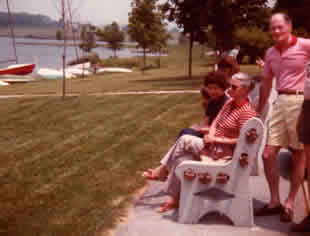
Elaine Manning-Ferrell, Bob Craig and Phyllis Manning-Craig on the same trip when he took us sailing
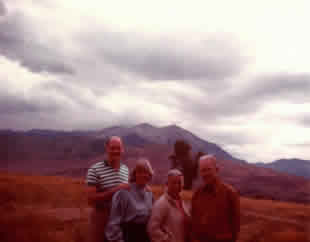
Bob Craig, my mother, Phyllis and my father when they visited in Colorado.
The mountain behind them is Mt. Sopris and the view was from my sister Ingrid's house in Carbondale, Colorado.
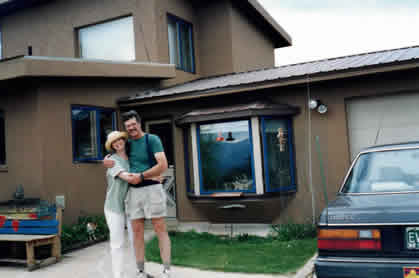
My sister Ingrid and her husband, John Siedel at their home in Carbondale, Colorado. They live in San Luis Obispo, CA now.
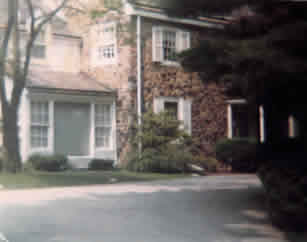
The Phillip Kirkman Manning and Elsie Jenelia Garrett-Manning house in Bryn Mawr, PA. These are the parents of Margarage Elaine Manning-Ferrell and Philis Manning-Craig. We took this picture at the same family get together in the early 80's when we visited there.

Phillis Garrett and her son, Peter Garrett at a Mission style church
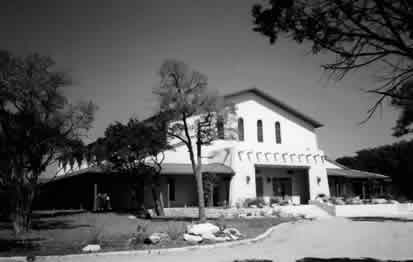
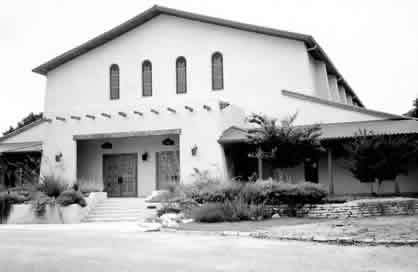

David L. Garrett, an older brother of Elsie

David L. Garrett with his wife, Cordelia, in their later years.
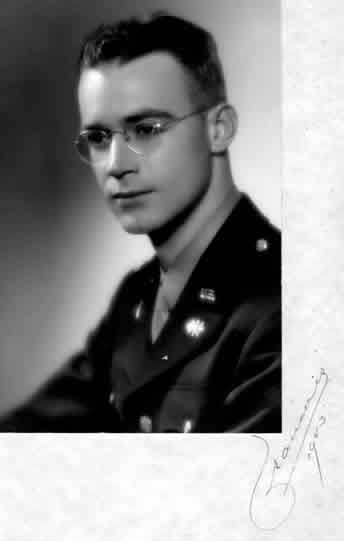
Mr. Garrett from when he was in the signal corp during WWII
.jpg)
Phyllis Garret senior picture from high school
.jpg)
Phyllis Garret in Aspen, Colorado

Phyllis Garret in 1st or 2nd grade

Phyllis Garret in 7th or 8th grade

Phyllis Garret in banner girl picture from junior high. I am the second from the right

